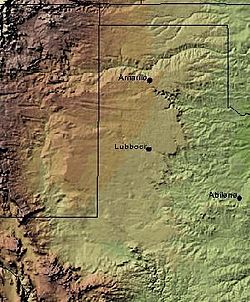This article needs additional citations for verification .(December 2009) |
Caprock Escarpment | |
|---|---|
 Caprock Escarpment, Garza County, Texas | |
 The Caprock Escarpment marking the edge of the Llano Estacado is clearly visible in this shaded relief image. The escarpment can be seen on the eastern edge of the Llano, running roughly in a north–south line through the middle of the Panhandle of Texas. | |
| Coordinates: 34°54′35″N104°04′08″W / 34.90972°N 104.06889°W | |
| Location | New Mexico and Texas, United States |
| Age | Quaternary |
| Geology | Caliche |
| Elevation | 502 m (1,647 ft) |

The Caprock Escarpment is a term used in West Texas and Eastern New Mexico to describe the geographical transition point between the level High Plains of the Llano Estacado and the surrounding rolling terrain. [1]
Contents
In Texas, the escarpment stretches around 200 mi (320 km) south-southwest from the northeast corner of the Texas Panhandle near the Oklahoma border. The escarpment is especially notable, from north to south, in Briscoe, Floyd, Motley, Crosby, Dickens, Garza, and Borden Counties.
In New Mexico, a prominent escarpment exists along the northernmost extension of the Llano Estacado, especially to the south of San Jon and Tucumcari, both in Quay County, New Mexico. Along the western edge of the Llano Estacado, the portion of the escarpment that stretches from Caprock to Maljamar, New Mexico, is called the Mescalero Ridge. [2] [3]